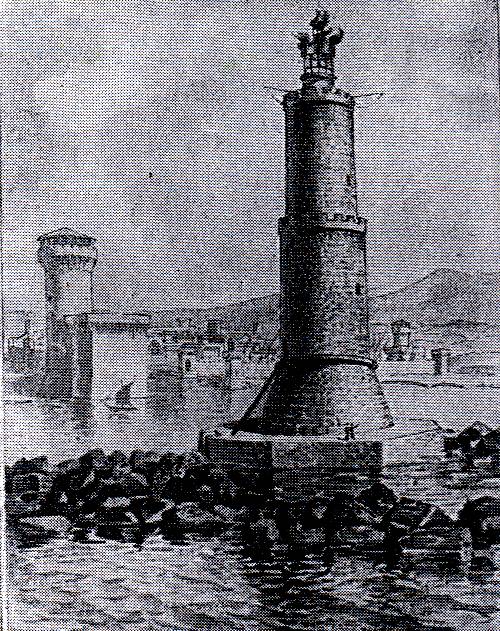Fu edificato nel 1302 dalla repubblica Pisana sia come fanale sia come difesa costiera, dopo che nel 1286 i genovesi distrussero la torre della Meloria in seguito alla vittoria sui pisani del 1284. Se ne attribuisce il progetto a Giovanni Pisano, mentre si conoscono con certezza i nomi dei capimastri ritrovati incisi su una pietra alla base della torre. Nocco EntelloDe Spina e Bonaggiunta Ciabatti.
Il fanale era in pietra delle cave di S. Giuliano con una larga base conica sulla quale, proprio come ora, sembrano poggiarsi due tronchi di cono l’uno su l’altro, ciascuno dei quali terminanti con una corona merlata. In realtà si tratta di sette cilindri sovrapposti con diametri progressivamente decrescenti. Si raggiungeva la sommità tramite una scala a chiocciola con soste a diversi ripiani con finestre, il faro compresa la lanterna raggiungeva i 51 metri.
It was built in 1302 by the Pisan republic both as a lighthouse and as a coastal defense, after the Genoese destroyed the Meloria tower in 1286 following the victory over the Pisans in 1284. The project is attributed to Giovanni Pisano, while the names of the master builders found engraved on a stone at the base of the tower. Nocco Entello De Spina and Boniacca Ciabatti.
The light was made of stone from the quarries of S. Giuliano with a large conical base on which, just as now, two trunks of cones seem to rest on each other, each of which ending in a crenellated crown. In reality they are seven superimposed cylinders with progressively decreasing diameters. The top was reached via a spiral staircase with stops at different shelves with windows, the lighthouse including the lantern reached 51 meters.
Nel 1583, il Granduca Francesco I fece costruire la base una struttura adibita a lazzaretto e poi a magazzini.
La bellezza della torre originaria le valse le lodi di Petrarca, che la cita nel suo “Itinerario siriaco”, quelle del cronachista fiorentino Goro di Stagio Dati, che la definì uno dei più bei fari del mondo; pare abbia addirittura ispirato Dante nel celebre verso “sta come torre ferma che non crolla / giammai la cima per soffiar di vento”. Galileo Galilei vi compì numerosi esperimenti per la messa a punto del suo cannocchiale.
In 1583, the Grand Duke Francesco I had a structure built at the base used as a lazaret and then as warehouses.
The beauty of the original tower earned it the praises of Petrarch, who mentions it in his “Syriac itinerary”, those of the Florentine chronicler Goro di Stagio Dati, who defined it as one of the most beautiful lighthouses in the world; it seems to have even inspired Dante in the famous verse “it stands as a stationary tower that never collapses / the top never collapses to blow the wind”. Galileo Galilei carried out numerous experiments there for the development of his telescope.
La costruzione del Fanale si rese necessaria in seguito alla distruzione della lanterna della Meloria, irrimediabilmente danneggiata dai Genovesi nel 1284. Nel 1584 il granduca Francesco I fece erigere dei magazzini nel basamento ed adibì la lanterna a lazzaretto, il primo in Italia dopo Venezia
The construction of the Fanale became necessary following the destruction of the Meloria lantern, irremediably damaged by the Genoese in 1284. In 1584 the Grand Duke Francesco I had warehouses built in the base and used the lantern as a hospital, the first in Italy after Venice
Del Fanale cantano l’Alighieri, il Petrarca ed altri ancora; andò distrutto il 20 Giugno 1944 ad opera dei guastatori tedeschi di Kesserling e ricostruito com’era ed inaugurato il 16 Settembre 1956 nell’anno delle celebrazioni per il 350° anniversario della proclamazione di Livorno città.
Of the Fanale sings Alighieri, Petrarca and others; it was destroyed on 20 June 1944 by the German sappers of Kesserling and rebuilt as it was and inaugurated on 16 September 1956 in the year of the celebrations for the 350th anniversary of the proclamation of Livorno city.



